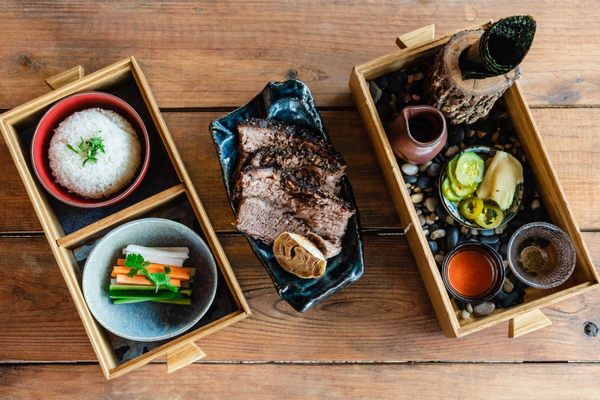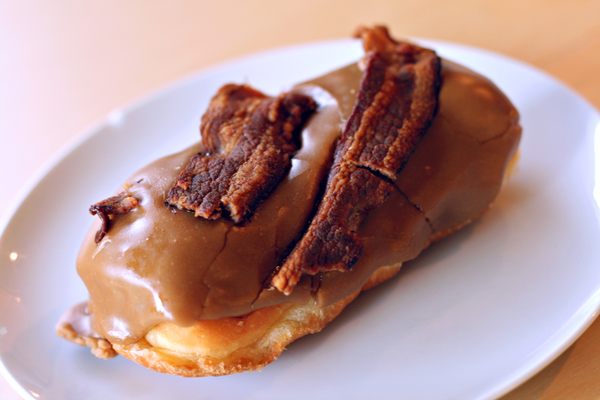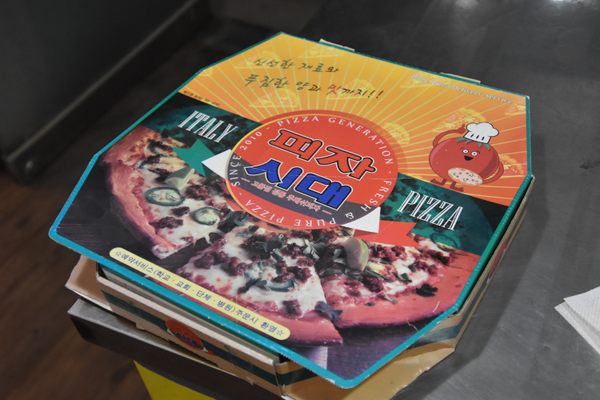Go Beyond the Beef at Korean Barbecue
Enjoy sizzling shellfish and duck over charcoal.
THIS ARTICLE IS ADAPTED FROM THE MARCH 23, 2024, EDITION OF GASTRO OBSCURA’S FAVORITE THINGS NEWSLETTER. YOU CAN SIGN UP HERE.
I grew up in Flushing, the home to Queens’ Koreatown. Or as we call it, the real Koreatown. It’s where 60 percent of Korean New Yorkers actually live, as compared to the over-the-top, Times Square-like entertainment center that’s become Manhattan’s K-Town.
After the Immigration and Nationality Act of 1965 removed national-origin quotas that favored European countries, the population of Korean Americans rose from 11,000 in 1960 to 290,000 in 1980, as they found their new homes in metropolitan areas of California, New Jersey, and New York.
That statistic includes my parents: my dad, a now-retired jewelry store owner in Harlem, and my nurse mom who worked throughout the worst years of the Covid-19 pandemic. Somehow, my mom still found the time to grill the most delectable meat, serving it with lettuce grown in her garden.
Nothing engages all the senses like Korean barbecue. And I’ve been privy to all of its forms both at home and at restaurants since childhood.
In recent years, Korean grill houses have become mainstream. Bulgogi and galbi are now part of the American foodie’s vernacular, but there’s so much more to Korean barbecue than beef and pork. There are live clams, frothing with liquor on grill slats. There are buoyant and buttery chunks of eel crackling over red charcoal embers.
Some of these proteins are eaten for special occasions, and often they come seasoned and prepared in a certain way. They all are grilled right at the diner’s table with a line-up of banchan that make for a magnitude of flavors—savory, smoky, sour, spicy—and textures, from the crunch of the lettuce wrap to the teeth-sinking tenderness of the meat.
Here’s a look at four special kinds of Korean barbecue, along with a list of restaurants in the States that specialize in them.
Duck Barbecue or Ori Gui (오리 구이)

In Korea, as in the U.S., duck is considered a premium meat for a special occasion. Since the philosophy of food as medicine is imprinted into our culture, health concerns draw Koreans to duck’s nutritiousness: collagen for beauty benefits and unsaturated fats (which don’t clog blood vessels in the way other animal proteins do).
At grill houses specializing in duck, the meat comes out sliced into thin, marbled rounds or chopped into chunks, either lightly salted or marinated. These are often cooked on a tilted grill pan that allows for excess grease to drip out.
Once the duck is cooked, get to making wraps. Dip the sizzling duck into a blend of Korean mustard and soy sauce. Add that to any of the wrapping leaves (usually lettuce and/or kkaenip, perilla leaves) along with a dollop of rice. Top it off with the grilled kimchi and seasoned chives that are usually served with duck.
Leave room for leftover magic. The servers scoop rice onto the grill pan and mix it together with the remaining duck and kimchi for bokkeumbap, carefully scorching the bottom for an extra charred, umami flavor.
Where to find it
In New York City: Daori BBQ, Kumsung BBQ, Han Joo. In Atlanta: Tofu Village Korean BBQ. In Los Angeles: Sun Ha Jang.
Eel Barbecue or Jangeoh Gui (장어구이)

Barbecued eel—one of my favorite grilled meats—is a rich, buttery treat that chars and curls as its skin contracts over hot charcoal.
Unfortunately, a number of factors limit its availability in the U.S. Compared to beef or pork barbecue, the demand for eel is not as high. Even among Koreans, it’s extolled as a special-occasion health food, whose oily, protein-heavy content lends itself to replenishing gi (기) or life energy.
In Korea, eel’s popularity peaks during the low-energy, dragging days of summer. The dish also requires eels to be stored alive in fish tanks, and a chef on staff needs to be experienced with handling live eels.
Here’s how to enjoy barbecued eel: Dip the crackling-hot eel into a sauce of sesame oil mixed with salt along with black pepper and/or spicy red ssamjang; drop that into a leaf of lettuce, add a spoonful of rice if you like, and top it with the customary pickled ginger. Then, plop the whole thing in your mouth for kaleidoscopic flavors and textures in every bite.
Where to find it
In New York City: Yuk Jun Gui. In Palisades Park, NJ: Jang-eo Jip. In Los Angeles, CA: Soot Bull Jeep.
Chicken Barbecue or Dakgalbi (닭갈비)

The word dakgalbi, which translates to chicken ribs, is a misnomer that hints to its storied past.
Long ago, it was a more affordable substitute for pork ribs, and it uses the same spicy seasoning as jeyook gui (spicy grilled pork). Lore also has it that a restaurant chef in Chuncheon in the Gangwon Province remixed the popular jeyook gui with chicken when he ran out of pork one day in the 1960s. To this day, Myeongdong Street in Chuncheon is so packed with dakgalbi restaurants—and patrons—that it’s nicknamed Dakgalbi Alley.
Thanks to Korean immigrants, you can have this tradition stateside, too. On top of the large round grill pan embedded into the table, the server lays out a glistening red mass of boneless chicken chunks in a gochujang-based sauce that typically includes chopped cabbage, chewy tteok (rice cakes) and wedges of goguma (Korean sweet potato). If you have to order these separately, don’t forego the tteok. They add a wonderfully bouncy texture and balance out the spicy seasoning.
Depending on the restaurant, the sides include lettuce and/or perilla leaf wraps and dongchimi, a refreshingly cold pickled radish broth that’s the perfect counterpoint to the hot and savory dakgalbi. Similar to the duck barbecue, leave room for bokkeumbap with add-ons like bean sprouts and extra gochujang-based seasoning.
Where to find it
In New York City: Doraon 1.5 Dakgalbi. In Houston: Lucky Palace Korean BBQ. In Palisades Park, NJ: Hong Chun Cheon Cheese Dak Galbi, Dumok BBQ.
Clam Barbecue or Jogae Gui (조개구이)

Since clams are a lighter meat, they’re typically eaten as a drinking food—for when you’re buzzed and have a hankering for a snack to prolong the boozy session. In Korea, clam barbecue became a happy hour fad among office workers about 10 years ago, although coastal towns like Busan and Incheon have always specialized in it.
Whole live clams are placed on grill slats in the middle of the table, where they slowly open up. When the liquor starts bubbling, the gloved servers pick up each clam, shuck them open with tongs and place them on the outer edges of the grill to cool down. Traditional accouterments include cho (vinegar) gochujang sauce for dipping.
While the clams are the main draw for me, I love ordering other shellfish, too: scallops topped with melty mozzarella cheese and cho gochujang, mussels, shrimp, crab, and a small pot of mollusks and squid strips simmered on top of the grill pan.
Where to find it
In New York City: Goo Gong Tan. In Fort Lee, NJ: Obaltan. In Los Angeles: Burnin’ Shell, Jae Bu Do.
Gastro Obscura covers the world’s most wondrous food and drink.
Sign up for our email, delivered twice a week.



























Follow us on Twitter to get the latest on the world's hidden wonders.
Like us on Facebook to get the latest on the world's hidden wonders.
Follow us on Twitter Like us on Facebook